Search the Special Collections and Archives Portal
Search Results
Ffolliott "Fluff" LeCoque oral history interview
Identifier
Abstract
Oral history interview with Ffolliott "Fluff" LeCoque conducted by Claytee D. White on September 24, 2012 for the African Americans in Las Vegas: a Collaborative Oral History Project. LeCoque talks about working with the first line of black dancers in a Las Vegas, Nevada Strip production at the MGM Hotel (currently Bally’s Hotel and Casino).
Archival Collection
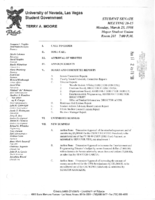
Meeting minutes for Consolidated Student Senate University of Nevada, Las Vegas, March 23, 1998
Date
Archival Collection
Description
Text
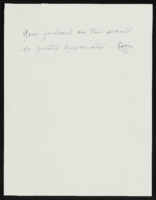
Roosevelt Fitzgerald: correspondence regarding UNLV Faculty merit awards
Date
Archival Collection
Description
From the Roosevelt Fitzgerald Professional Papers (MS-01082) -- Personal and professional papers file.
Text
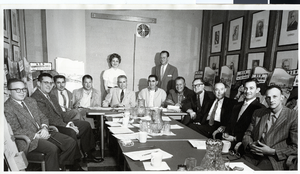
Photograph of Las Vegas Chamber of Commerce Board of Directors, 1961
Date
Archival Collection
Description
Image
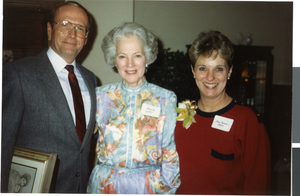
Photograph of Richard Bryan, Blanche Zucker and Bonnie Bryan at a President’s Child Safety Partnership event, January 1988
Date
Archival Collection
Description
Image
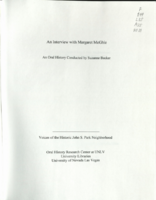
Transcript of interview with Margaret McGhie by Suzanne Becker, November 21, 2008
Date
Archival Collection
Description
Margaret McGhie was a Depression era child who grew up in western Nevada, where her grandparents were ranchers. Her mother, a native Nevadan, married an Italian immigrant, and she recalls moving a lot. Margaret attended a business college in Reno and eventually moved to Las Vegas, where she worked for Basic Magnesium (BMI) in Gabbs, NV and then later for a remanufacturing company where she verified rocket measurements. Only 16,000 people resided in Las Vegas in post World War II days when she moved there for work as her husband returned from military service. At the time lots for homes were selling in the new development of John S. Park. Using the GI bill the young couple became one of the first home owners on the street. The land had formerly been a ranch and orchard making it a beautiful spot. Due to post-war building material shortages it took nearly two years to finish the house construction. To this day Margaret lives in the home where she and husband raised four children. She recalls the neighborhood fondly and describes some of the activities that kept them busy, where they shopped, and how her children attended John S. Park Elementary School and then the local parochial schools. She describes how the town changed from a 10-minute cross-town drive and how the fact of living close to the Strip had little impact on their life. People moved from the neighborhood as the city grew, she says, moving to newer and nicer homes in Spanish Oaks and then Summerlin. The John S. Park neighborhood has changed from a formerly large Mormon demographic to a notable increase of Latino population. She sees the historic designation as a signal of pride in ownership for residents.
Text
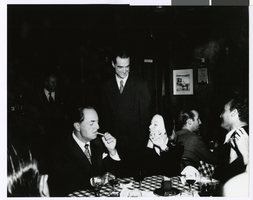
Photograph of Howard Hughes, William Powell, Veronica Lake, and Andr? Toth at the 21 Club, New York City, February 17, 1946
Date
Archival Collection
Description
Image
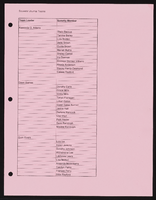
Alpha Kappa Alpha Sorority, Theta Theta Omega Chapter souvenir journal teams list
Date
Archival Collection
Description
From the Alpha Kappa Alpha Sorority, Incorporated, Theta Theta Omega Chapter Records (MS-01014) -- Chapter records file.
Text
Margaret (Peggy) Casey oral history interview
Identifier
Abstract
Oral history interview with Margaret Casey conducted by Claytee D. White on January 13, 2005 for the Boyer Early Las Vegas Oral History Project. Margaret Casey discusses the female workers during World War II (WWII). She discusses Las Vegas, Nevada history during the mid-century. She also discusses the Mesquite Club, the ways of family life including the grocery stores, restaurants and the various leisure activities like gardening and golf. Casey then discussses topics such as the atomic testing, Howard Hughes and the transformation of Las Vegas' transportation and downtown.
Archival Collection
Dr. Carolyn Reedom oral history interview
Identifier
Abstract
Oral history interview with Dr. Carolyn Reedom conducted by Kristina Knebl on November 22, 2006 for the Public School Principalship Oral History Project. In this interview, Dr. Reedom reflects upon her 28 years as a principal in Nevada’s Clark County School District (CCSD). She discusses the process by which she became an elementary school principal, and compares it with when she served as a high school principal. She discusses her approach to school administration, and how her experience as a 27-year old principal of Red Rock Elementary School shaped her career. She also describes her experience with school desegregation, and explains why she believes it was desegregation instead of integration.
Archival Collection
